The Soldier's Details

- Surname:
- Ironmonger
- First Name:
- Charles Henry
- Nick Name:
- Charlie
- Rank:
- Corporal
- Regimental #:
- WX8327
- Company:
- 'C' Company Headquarters
- Enlisted:
- 21.08.1940
- Discharged:
- 13.12.1945
- DOB:
- 5.05.1899
- Place of Birth:
- Corby, Northamptonshire, England
- Father's Name:
- William Ironmonger
- Mothers's Name:
- Sarah Jane Ironmonger (nee Humphries)
- Religion:
- Church of England
- Pre-war Occupation:
- Dairy Farmer
- Singapore:
- Selarang Camp and Barracks Changi; Garden Control Party; A.G.H. Roberts Barracks Changi; Kranji Hospital Woodlands; Changi Gaol Camp
- POW#:
- 3/8250
- Return Details 1945:
- Singapore-Darwin-Sydney, HMT Arawa; Sydney-Melbourne by troop train; Melbourne-Fremantle, HMT Strathmore
General Description
Charles Henry Ironmonger
Charles Ironmonger left school at the age of 13 and was working for his father in the family coal and wagon business. He described this as “working for his father 6 days a week, for nothing of course.”
On August 14th, 1914 while carting goods for the construction of a sewage system in the village he got caught between the wagon wheel and a fence and ended up with a broken leg and lots of skin missing. A doctor set his leg on the floor in the front room of their house and he was carried upstairs in the carpet to his room. As written in his notes. “I was sick all night, but the old man never came near me. Then I made up my mind to get a job as soon as I could.”
In March 1915 he got his first job working in a blast furnace for 4/- a day. “I thought I was a millionaire.”
Early May there was big recruitment campaign for the Army in England and on the 5th May 1915, his 16th birthday, Charles joined the English army, lying about his age so he could enlist.
“I had never been away from home before this and it was with mixed feelings that I left. I remember my dad said the night I joined up that I had made my bed so I could lie in it. He couldn’t have said anything better to make me determined to stick it out. Before I had been in the army 2 months he wrote me to see if I would come home. No was the answer and he had sense enough to let it go at that, as he could have claimed me had he so done.”
Charles started his training in Weymouth and transferred to Gillingham. “After finishing the rifle course for which I got cross guns we transferred to another camp on the other side of Gillingham and we were anxious to get to France. Little did I realize what it would be like to have some one firing at me when before I was the only one firing.
We had a very sensible Sgt Major in our Company, a real old timer, probably had a family as old or older than I was. Wheb the drafts were made up he would keep our names off. He knew we were not old enough to go to France. Sometimes we would go to see him in his tent and say we wanted to volunteer for France. He would say get the hell out of here or you’ll get my boot where it hurts. There were a number of us young lads like that, some parents claimed, some got old enough to go until there were only two of us in my Company. So the Sgt decided to get rid of us for a while and sent us to Woolwich, for a course of shoeing horses that took two to three months. When I came back I could wear a horse shoe on my sleeve. From then on till Oct 1916 I was doing guard duties. A blizzard hit camp and blew everything flat and what a mess. Everything had to be put up again then the news came that I was on draft for France.
Home leave. I told them that I was going to France to shoe horses. I’m afraid I never put a shoe on a horse after I left Woolwich till I came to Australia in 1922.”
At 17 Charles was sent to France and first stationed at Corbie on the Somme. During March 1917 he was called to the Orderly Room where the adjutant questioned him about his age. “Evidently someone had written to him and told him I was under age. It turned out to be my brother-in-law who was a Lt. in the Leicesters.”
At this time Charles was sent back to England, transferred to the 2/6 Scottish Rifles and sent to Ireland. Most of the Battalion was youngsters who had been sent home from France.
Charles went back to France in February 1918 and spent time in and around Arras and Loos. In August 1918 they were all sent to the French Front at Chatteau Thierry.
“Marched 24 hrs then straight over the top. Had tremendous losses 17 men and a Sgt out of my Company of 200. Lost all officers (a bit different from WWII we couldn’t lose them if we tried). Some companies suffered worse.”
Charles was demobbed on 11th March 1919. “2 months before I turned 20 – only a kid in years but an old man in experience.”
Charles went back to England and settled in Leicester rather than Corby, “where I knew some people and my mother lived there. I soon found a job driving a furniture wagon but it didn’t last long before I was in the shop learning how to sell furniture.” After a number of jobs Charles decided to join the RIC (Royal Irish Constabulary) and went back to Ireland. Charles was part of the team that was sent to Belfast to guard King George when he opened Parliament there. He was then sent to Wood Laven in County Galway and there to protect Lord and Lady Ashtoun.
Charles was only in the RIC for 12 months when home rule was declared in Ireland, so they were all discharged but with 12 years service added to their pension. For Charles this turned out to be 1 pound per week. “I was 22 yrs of age quiet a lot of experience 4 years war 1 year in police retired on pension.”
Charles went back to England and worked as a salesman and window dresser in a furniture factory. He was a soccer player at the time. “I stayed with a cobber for a while till I got some good lodgings. We used to do a good bit of running those days. Used to train in Sheffield Wednesday football ground. He was a good sprinter we were both in the team that won the divisional cup after the armistice in France.”
“I didn’t hold my job long though it wasn’t my fault so much. One of the bosses tried to take a rise out of me with a shop full of people. Being young and carefree I just cracked him and drew my weeks pay on Monday morning, went back to Leicester, no work so decided to go to Australia on assisted passage. Got married to a girl I had been living with for the past 18 months, 15 June 1922 had 3 days in London while waiting for ship, Left London 18 June 22, by way of S Africa landed at Albany Aug after 6 week at sea to a new land with every chance to make good through our own effort.”
He arrived in Australia at Albany 1922 (Headstone). Australian Army Fact Card shows pre-enlistment occupation as Dairy Farmer. Had a dairy farm in the Group 34 Settlement in Yalyallup district (Near Busselton) in Western Australia.
Please read further about Group Settlement√
Enlisted in Australian Army in 1940 using a false birth date again (5 May 1901) so he would qualify. Went to WW II in Singapore. Spent 3 and a half years in Changi POW camp in Singapore as a prisoner of the Japanese. Returned to Australia from Singapore in 1945 after the war. War fact card shows trip back to Australia taken by ship and train. Singapore – Darwin – Sydney HMT Arawa. Sydney – Melbourne Troop train. Melbourne – Fremantle HMT Strathmore.
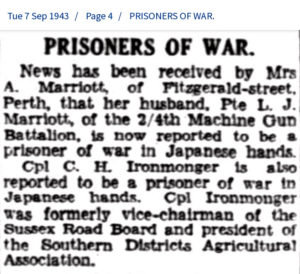
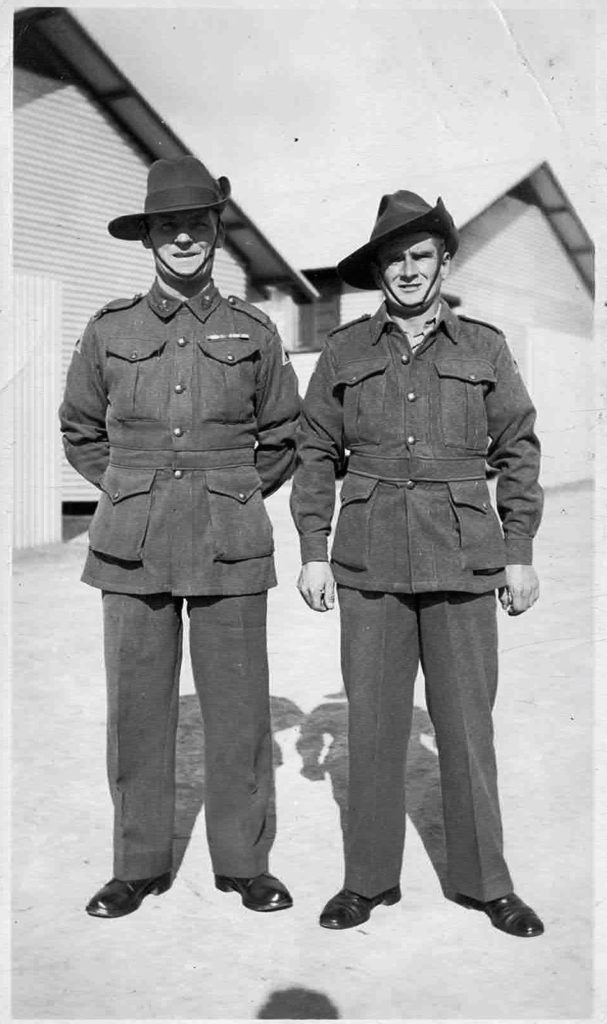
Charles Ironmonger on right.
Charles and Minnie separated after Charles returned home from WWII, and divorced in 1946. Charles moved to Karridale in Western Australia and started a new farm. This was a dairy farm until about 1970 when he changed to farming sheep and beef.
Charles married Dorothy Allan in about 1947.
Dorothy died in 1953.
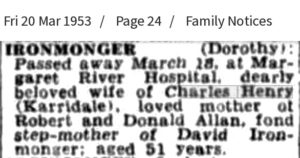
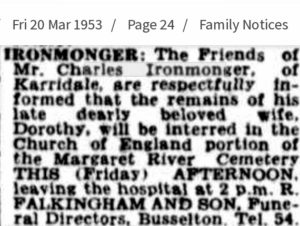
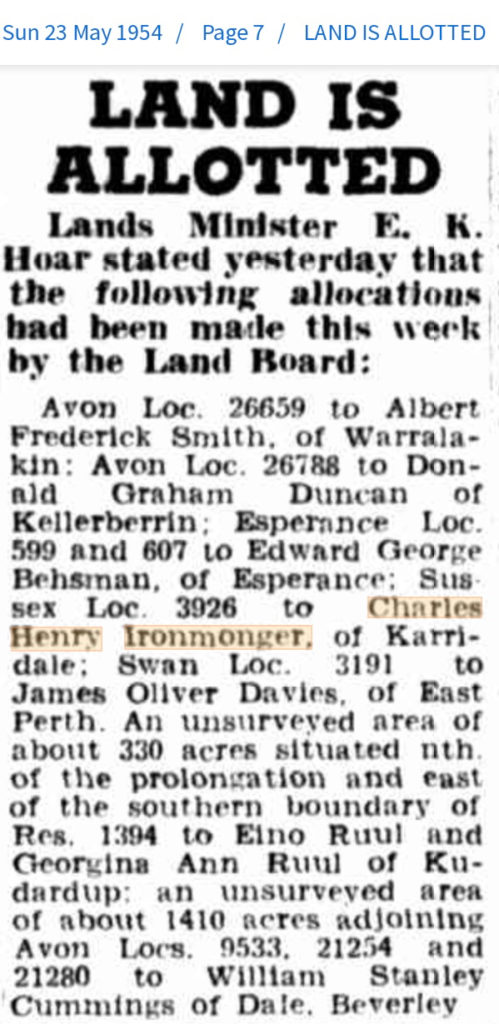
Moved from the farm in the late 1970’s to Busselton. Did not take to town life and after 3 years moved back to a smaller farm at Deep Dene Western Australia. He had gotten used to the house layout in Busselton and had the new house built on farm with the same floor plan as the house in Busselton.
Lived there until his death from cancer 10th April 1987. Charlie is buried at Karridale cemetery.
The above information is courtesy of the following website. http://familytree.ironmonger.com/tree/42/Charles-Charlie-Henry-Ironmonger-1899—1987.tpl Thank you to his family for sharing this.
Charlie Ironmonger remained in Singapore as POW and was part of the Garden Party. He was 6’1” tall.
He was admitted to hospital twice throughout his stay. He was recovered from Kranji Camp (Woodlands) on 31 August 1945.
You can read further about Group Settlements
Charles passed away in mid 1987 and was buried Karridale.
Camp Locations:
- Changi Gaol Camp - Singapore
- Kranji Camp Woodlands - Singapore
- Roberts Barracks Changi - Singapore
- Selarang Barracks Changi - Singapore
- Selarang Camp Changi - Singapore






